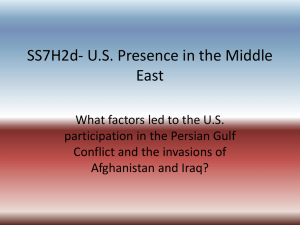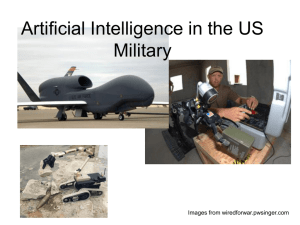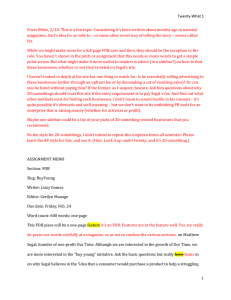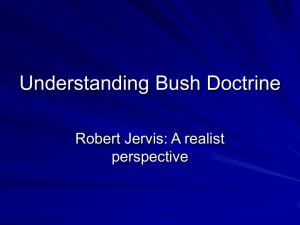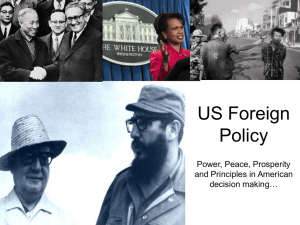Military Operations in Afghanistan and Iraq
advertisement
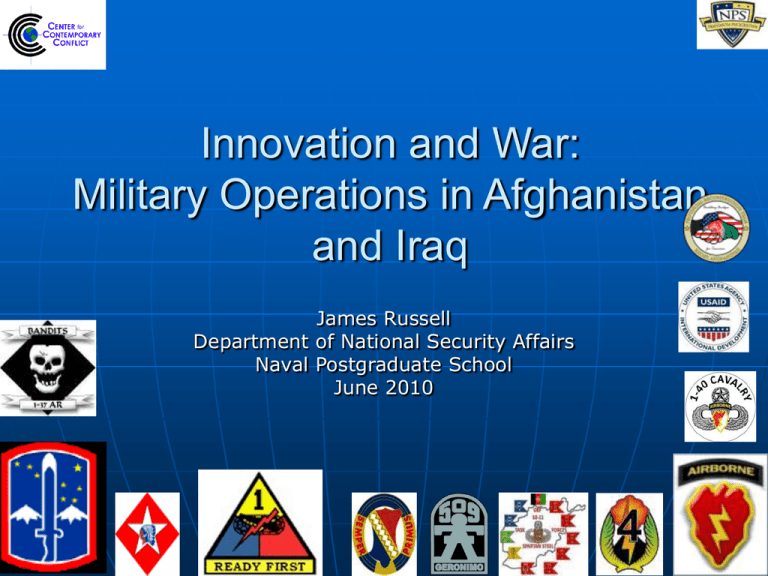
Innovation and War: Military Operations in Afghanistan and Iraq James Russell Department of National Security Affairs Naval Postgraduate School June 2010 Outline Project Background • Iraq, Afghanistan Focus on empirically built cases of units as they conduct operations. Up Front Punch line Analysis of US military operations in Iraq and Afghanistan show organizations that can quickly adapt, change, and innovate while closed with the enemy. Nonsense to suggest that insurgents are somehow more creative, flexible, and adaptive. I’m not arguing that this wins the war! Basis for This Statement? 172nd SBCT, Ninewa Province /Mosul, 20052006 3rd Battalion, 6th Marine Regiment; 1st Marine Battalion, 7th Marine Regiiment, Al Qaim, 20052006 4-14 Cavalry Group, Rawah, Western Anbar, 2005-2006 Unit Locations 2/28 Brigade Combat Team; 1/1 Brigade Combat Team, Ramadi, Anbar, 20052007; 1st Battalion, 37th Armored Regiment; 2nd Battalion, 7th Marine Regiment (both attached to 1/1 in Ramadi, 20062007) Iraq cases of empirically built cases of 9 Army and Marine Corps battalions in 0507. Chronicle fieldlevel adaptive and innovative processes. Findings from Iraq Research Organizations developed new, indigenous organizational capacities. • Dialectical process that cannot be described solely as topdown, or bottom up – though execution process is generated organically. • Innovation is the end product of a series of linked processes that builds organizational capacities that deliver outputs that didn’t exist before the unit arrived. New capacities required modification to organizational structures. • S-2 shops, non-kinetic effects working groups, JIATFs. • New small unit tactics to disrupt insurgent ops. Units gradually built new SOPs to operationalize new capacities. • Census Operations. • COP construction. • CMO and IO integration into lethal/non-lethal targeting. Other Iraq Inferences Role of doctrine miscast by security studies theorists: • Capstone operational doctrine is foundation to innovation; lack of specific COIN doctrine not important in these cases. Informal doctrine important tool. Organizational hierarchy operates differently in war than in peace – no surprise, but… • Ad-hoc org structures; flattened organizational hierarchy; authority driven down the chain of command; informal relationships a great source of organizational productivity; embrace of systems-based based perspectives to understand second and third order effects of actions as a guide to decision-making. Innovation and Adaptation in War: The Case of 4/25 in P2K Saba Musa Khel ri Qal and ar Nadir Dow Shah Man man Khot dozay dah i Tani Sper a Jaji Maida n Bak Mat un Tere Zayi Gorb uz 4 # Zerok COP FOB Munoz FOB Orgun-EFOB Tillman FOB Boris FB Lilley FOB Curry 4/25 Adaptation – the Good 4/25 Board of Directors – A Campaign Plan! • AID, Agriculture, State, BDE Commander • Attempt to involve other USG elements in the stabilization/COIN effort Immense array of additional organizational/TF support – the alphabet soup approach • Human Terrain, PRT, Law Enforcement Program, ADTs, JIEDDO, SOF, Intell orgs of every stripe to help in targeting, detainee ops., all built through ad-hoc, JIATFtype organizations. This is one model for how to organize diverse organizational components conduct stability operations in modern era. Military remains provider and enabler…. TF Yukon Leadership Yukon Board of Directors DoS James Story Team Khowst USAID Louis Coronado USDA DoD Gary Domian COL Howard Team Paktya Team Paktika • DoS Sarah Groen • DoS Genevieve Libonati • DoS Trevor Boyd • USAID Teresa Miller • USAID John Koogler • USAID Daniel Weggeland • USDA Feridoon Mehdizadegan • USDA Vacant • USDA Carolin Clarin • BSO LTC Stephen Smith • BSO LTC Rob Campbell • BSO LTC Clint Baker LTC Pete Minalga • PRT CDR John Pestovic • PRT LtCol Carlos Halcomb • ADT COL Brian Copes • ADT COL Jim Moore • PRT CDR Tim Cauthen The Case of 3-509 in EPaktika Significant initiative at BN levels to structure their own operations. Organizing for the fight. Driving responsibility down the chain of command – IO, survey data collection. Tactical organizational complexity that mirrors command level. Zerok COP FOB Munoz FOB Orgun-E FOB Tillman FOB Boris FB Lilley FOB Curry Districts 9 Sq KM 6204 -About the size of the big island of Hawaii Population ~300,000 125 KM of Border with Pakistan PAKMIL Checkpoints 51 Initiative Spotlight: 1-501 Sub-Governor Budget Pilot Program 1. Targets the legitimacy gap at the District 2. Provides Government with a simple means to improve the community 3. Record keeping, dispute resolution, and consultative processes codified in documents 4. Employs the local community and fosters a sense of ownership Preliminary Conclusions from Iraq and Afghanistan Research Process of battlefield innovation is complex mix of top-down, bottom up process: dialectic in nature. Afghan: top down guidance and doctrine shape approach, but significant variation on unit basis, just like Iraq. Iraq parallels: units get it, upper- mid- and lower levels all get it. Educated, experienced work force. • Organizations extremely flexible to build new output capacity. Organizational learning happens but is idiosyncratic; doctrine does not smooth this process.
